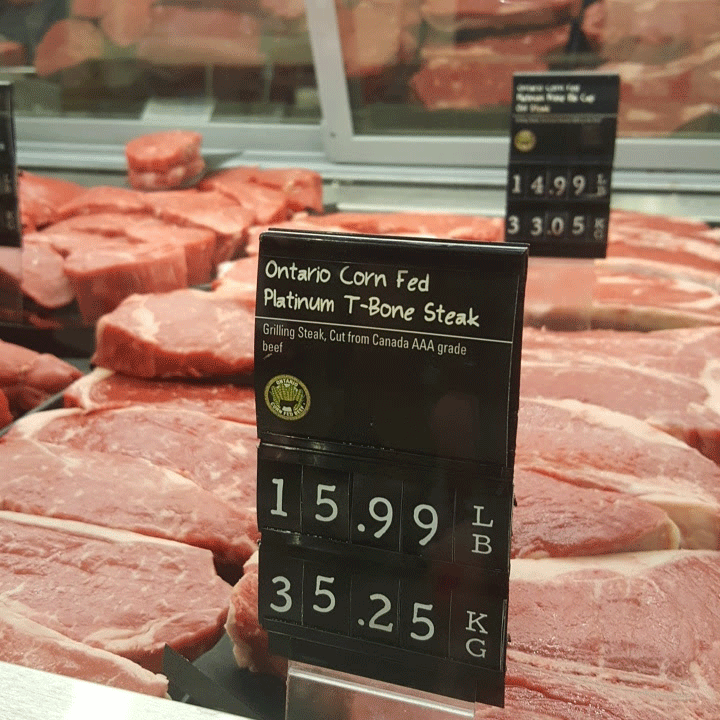Quality inputs, quality product
ONTARIO CORN FED BEEF

ONTARIO’S GRAIN FARMERS provide the province, country, and world with high-quality, safe grain with a multitude of uses. One market that is particularly close to home is livestock feed — specifically Ontario beef.
The Ontario Corn Fed Beef program is managed by the Ontario Cattle Feeders Association, and is the largest producer-owned branded beef program in Canada. Their mandate is to provide high quality locally produced beef for consumers and value for producers utilizing cattle fed a corn-based ration.
The Ontario Corn Fed Beef (OCFB) program is made up of over 500 family farm members that produce about 55% of the corn-fed cattle in Ontario – a little over nine per cent of all cattle marketed in Canada.
“The livestock industry is very important for Ontario commodities. For corn it is the number one market that utilizes the commodity,” says Nicole Mackellar, manager of market development for Grain Farmers of Ontario. In fact, 60 per cent of the grain corn produced in the province is directed towards animal feed.
“Ontario produces high quality corn which contributes to consistently great tasting Ontario Corn Fed Beef,” says Adam Hill, quality assurance manager for the OCFB program. “Corn quality is extremely important when it comes to the feed conversion within the animal and the overall growth and performance of the animal. Consistency of the feed is very important in the animal’s diet.”
According to Hill, the energy content of corn promotes the production of consistently well marbled beef. The high level of starch in the corn Ontario farmers grow is a significant component of their program.
“Due to our growing climate, Ontario farmers produce corn that is high in bushel weight and quality which makes excellent feed,” says Hill. “It takes high quality corn to produce consistently great tasting beef. Ontario produces high quality grain corn that OCFB feedlots require to meet the nutritional requirements of the OCFB program.”
That’s why a key element to the program is the producer relationship with their nutritionist. Working with a livestock nutritionist ensures the animals are receiving the high quality of feed with the optimum level of protein to benefit the performance of the animal. It all comes down to the balanced ration and knowing the feed quality levels as tested by a feed laboratory, says Hill.
GROWING MARKET
Ontario Corn Fed Beef is listed in more than 360 grocery and retail outlets across Ontario, and is served at major restaurant and food service providers. Currently, OCFB is expanding into major export markets including Japan, China, and the Middle East.
“Grain Farmers of Ontario has worked with Ontario Corn Fed Beef for a number of years now. OCFB is working to expand their brand and products in key export markets from around the world. Part of their brand story is based around the positive contribution to quality beef that corn feeding provides. Corn is what allows for OCBF to have its rich, full flavour. For Grain Farmers of Ontario, we saw it as an opportunity to highlight the high quality corn we are growing in the province that is used to produce a superior product,” says Mackellar.
According to Hill, the OCFB program is the only one in Canada that specifies a minimum percentage of corn products in the finishing ration, and because of their commitment to quality assurance, the OCFB program was awarded the Canadian Beef Industry’s Innovation & Sustainability Award in 2016.
“Since 2012, the program has produced an average of 275,000 head of program cattle, which represents close to 50 per cent of all fed cattle slaughtered in the province. With strong interest from many cattle feeders to join the program, we project to see continued growth over the next five years which provides increasing demand for Ontario grain corn products,” says Hill. “Many OCFB feedlots require significant quantities of corn products over and above their own production capabilities to meet their feed ration requirements. OCFB feedlots are one of the largest consumers of Ontario corn, and strong relationships between Ontario grain farmers and OCFB feedlots are critical to each organization’s long term success and provide mutually beneficial opportunities.”
Mackellar says, “working with OCFB on this project has been a great experience. They are committed to highlighting all of the positive attributes Ontario corn provides to their program. It has also allowed us to gain information on new market opportunities for Ontario corn exports. We hope to continue working with the OCFB and the Ontario Cattle Feeders Association on future initiatives like this.” •






















